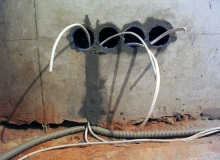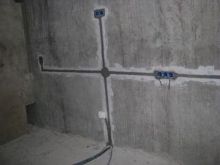Categories: Sharing experience, Electrician at home
Number of views: 35870
Comments on the article: 1
Installation of electrical wiring in concrete floors
Electrical wiring in the house: installation features
 Not so long ago, in Soviet times, wiring was decided to be routed around the rooms strictly along the walls, switches and sockets should be installed in uncomfortable places for use, often making room furniture difficult. Today, the usual “wall” installation is being replaced by floor, or more precisely, underground.
Not so long ago, in Soviet times, wiring was decided to be routed around the rooms strictly along the walls, switches and sockets should be installed in uncomfortable places for use, often making room furniture difficult. Today, the usual “wall” installation is being replaced by floor, or more precisely, underground.
Laying the electrical network under the floors is much more convenient from the point of view of economy, because the wires are mounted directly, along the shortest path, which can reduce the consumption of materials sometimes up to 40% (!). In addition, hidden in the floor wiring implies absolutely free placement of furniture. Sockets they won’t loom in the middle of the wall: they can be led directly to the equipment, for example, hidden under a computer table, even if this table is in the middle of the room.
For the installation of "underground" wiring use special corrugated pipes or PVC box, as well as combined options - a box with pipes. Instead of PVC elements, metal can be used, but they are much higher in price, and much more difficult to install: you will at least need a welder. Plastic pipes are easily mounted independently and are affordable.
 The main feature of the "underground" installation work is the presence of a wiring project or, in extreme cases, at least an approximate sketch on which the main electric points will be applied.
The main feature of the "underground" installation work is the presence of a wiring project or, in extreme cases, at least an approximate sketch on which the main electric points will be applied.
Installation of the power grid begins with the laying of pipes (or ducts) to the places of the outlet groups according to the engineering project. Pipes are fixed with cement mortar in places of bends and joints. Inside each pipe, a steel wire is tightened, which will further help to introduce wires into the system. After that, the floors are poured with concrete mortar.
After the floor has dried, wires and cables are laid through the pipes. For convenience, a separate pipe is laid on each outlet group, which will subsequently facilitate the replacement or modernization of the electrical network, and also, if necessary, will help to quickly detect and eliminate the malfunction.
According to the rules of electrical work, the length of a single piece of pipe should not exceed 20 m and have more than two turns at a right angle. To extend the network, it is recommended to use transit boxes.
The corrugated pipe should not be filled with more than 35-40% wiring. The conclusions of each pipe should be marked, indicating the type of network, the length of the section and the marking of the wires laid inside.
Network laying is carried out on the main (trunk) and auxiliary (branch) channels. The main channels conduct the main cables, and the branch ones bring the wires to the workplaces.
 "Underground" filling systems can consist of a number of additional elements: adapters, tees, various turns, junction boxes, inlets for installing floor outlets, etc. Their use determines the height of the concrete pouring. This must be taken into account at the design stage.
"Underground" filling systems can consist of a number of additional elements: adapters, tees, various turns, junction boxes, inlets for installing floor outlets, etc. Their use determines the height of the concrete pouring. This must be taken into account at the design stage.
In addition, the number of overlapping channels will also affect the height of the fill (the intersection at one point of several channels laid one on the other), for example, three auxiliary channels at the intersection will give a height of about 15 cm.
Electrical installation can be done on the floor and in open channels. At the same time, the PVC box must be laid in such a way that its top coincides exactly with the floor surface. To do this is quite difficult technically, and from a safety point of view is not too good: free access to wiring will be maintained over the entire surface along the duct.
In any case, whichever installation method you choose (open or closed, floor or wall), you should remember that well-made electrical wiring - a guarantee of your safety. So do not save on engineering projects and the work of specialists.
See also at bgv.electricianexp.com
:
